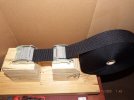To strop, or not to strop, that is the question. Well, good ol' Hamlet won't answer this question. I did not like a strop. For me it was not an improvement but seemed to dull the edge. Maybe I did it wrong. But as far as I know: Some like it. Some don't.
Some even use a quite coarse stone and then a strop. And it seems to work.
I know that stones of the same grit can produce a quite different edge. But - as a rule of the thumb - is it possible to say: If a stone has a grit of xy it is possible to remove the burr with just the stone and a strop is needless?
Hopefully this it not a silly question. Not more than else.
Some even use a quite coarse stone and then a strop. And it seems to work.
I know that stones of the same grit can produce a quite different edge. But - as a rule of the thumb - is it possible to say: If a stone has a grit of xy it is possible to remove the burr with just the stone and a strop is needless?
Hopefully this it not a silly question. Not more than else.

